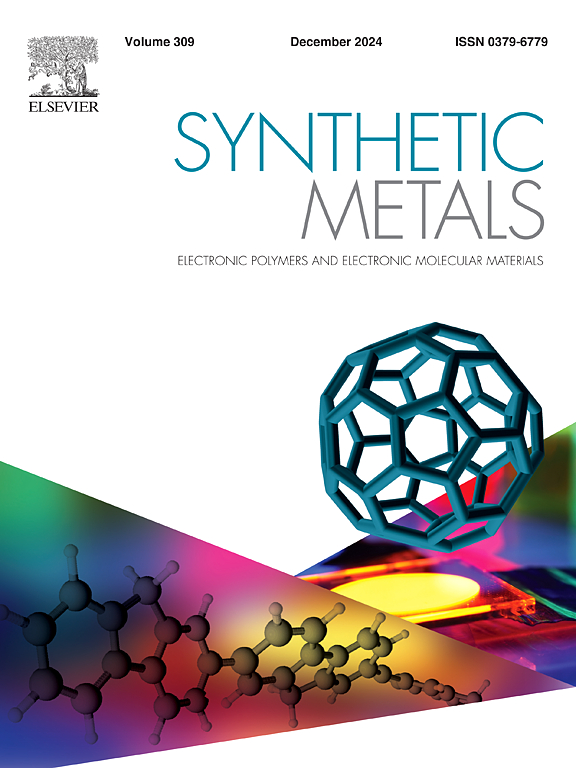Xanthan gum biopolymer gated low voltage-operating photo synaptic organic field-effect transistor for neuromorphic electronics
IF 4.6
3区 材料科学
Q2 MATERIALS SCIENCE, MULTIDISCIPLINARY
引用次数: 0
Abstract
Low voltage-operating light-stimulated organic field-effect transistors (OFETs) are attracting huge attention due to their potential for developing photonic neuromorphic synapse-based neural networks resembling the human brain. The OFETs based on environment friendly biocompatible materials and processability are highly desired for realizing photo synaptic elements. In this report, we demonstrate a low voltage-operating Xanthan gum-gated poly(2,5-bis(3-alkylthiophen-2-yl) thieno[3,2-b] thiophene) [PBTTT-C14] based OFETs, exhibiting photo synaptic behavior at 0.3 V. The basic photo response parameters such as photoresponsivity, detectivity, and photocurrent to dark current ratio of the OFETs are estimated to quantify the photo synaptic behavior of the OFETs. We report the fundamental neurobiological characteristics such as excitatory post-synaptic current (EPSC), pair pulse facilitation (PPF), short-term plasticity (STP), long-term plasticity (LTP), learning-forgetting-memorizing (LFM), and conversion of STP to LTP for the Xanthan gum-gated PBTTT-C14-based OFETs. Furthermore, we showcase the electronic "OR" logic operations by employing the OFETs and replicate the Pavlovian conditioning experiment to mimic the associative learning phenomenon. Using these photo synaptic OFETs, we replicate human emotion and mood-swing-dependence learning and memory behavior which is an important aspect of cognitive learning. The OFETs exhibit fairly low energy consumption 100 pJ per optical operation to perform synaptic responses. We interpret and attribute the observed neuromorphic behavior to the charge-trapping occurring at the semiconductor-dielectric interface and bulk traps in OFETs. The presented results broaden opportunities to the device communities for building artificial complex neural networks using energy-efficient bio-polymer gated photo synaptic OFETs.
用于神经形态电子学的黄原胶生物聚合物门控低电压工作光突触有机场效应晶体管
低电压工作的光刺激有机场效应晶体管(OFET)因其在开发类似人脑的光子神经形态突触神经网络方面的潜力而备受关注。基于环境友好型生物兼容材料和可加工性的 OFET 是实现光突触元件的殷切希望。在本报告中,我们展示了一种基于黄原胶门控的低电压操作聚(2,5-双(3-烷基噻吩-2-基)噻吩并[3,2-b]噻吩)[PBTTT-C14]OFET,在-0.3 V电压下表现出光突触行为。我们估算了 OFET 的基本光响应参数,如光致共振性、可探测性和光电流与暗电流比,以量化 OFET 的光突触行为。我们报告了基于黄原胶门控 PBTTT-C14 的 OFET 的基本神经生物学特性,如兴奋性突触后电流(EPSC)、对脉冲促进(PPF)、短期可塑性(STP)、长期可塑性(LTP)、学习-遗忘-记忆(LFM)以及 STP 到 LTP 的转换。此外,我们还利用 OFET 展示了电子 "OR "逻辑运算,并复制了巴甫洛夫条件反射实验,以模仿联想学习现象。利用这些光突触 OFET,我们复制了人类的情感和情绪波动依赖性学习和记忆行为,这是认知学习的一个重要方面。这种 OFET 在执行突触反应时每次光学操作的能耗相当低,仅为 100 pJ。我们将观察到的神经形态行为解释并归因于发生在 OFET 中半导体-电介质界面和体陷阱的电荷捕获。这些结果为设备界利用高能效生物聚合物门控光突触 OFET 构建人工复杂神经网络提供了更多机会。
本文章由计算机程序翻译,如有差异,请以英文原文为准。
求助全文
约1分钟内获得全文
求助全文
来源期刊

Synthetic Metals
工程技术-材料科学:综合
CiteScore
8.30
自引率
4.50%
发文量
189
审稿时长
33 days
期刊介绍:
This journal is an international medium for the rapid publication of original research papers, short communications and subject reviews dealing with research on and applications of electronic polymers and electronic molecular materials including novel carbon architectures. These functional materials have the properties of metals, semiconductors or magnets and are distinguishable from elemental and alloy/binary metals, semiconductors and magnets.
 求助内容:
求助内容: 应助结果提醒方式:
应助结果提醒方式:


